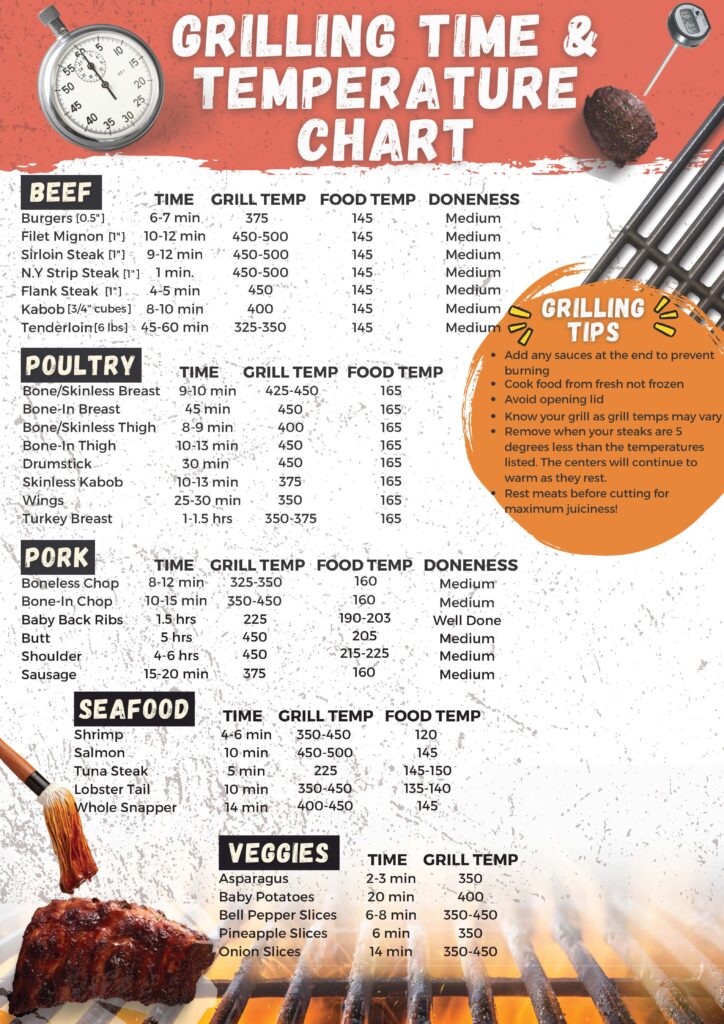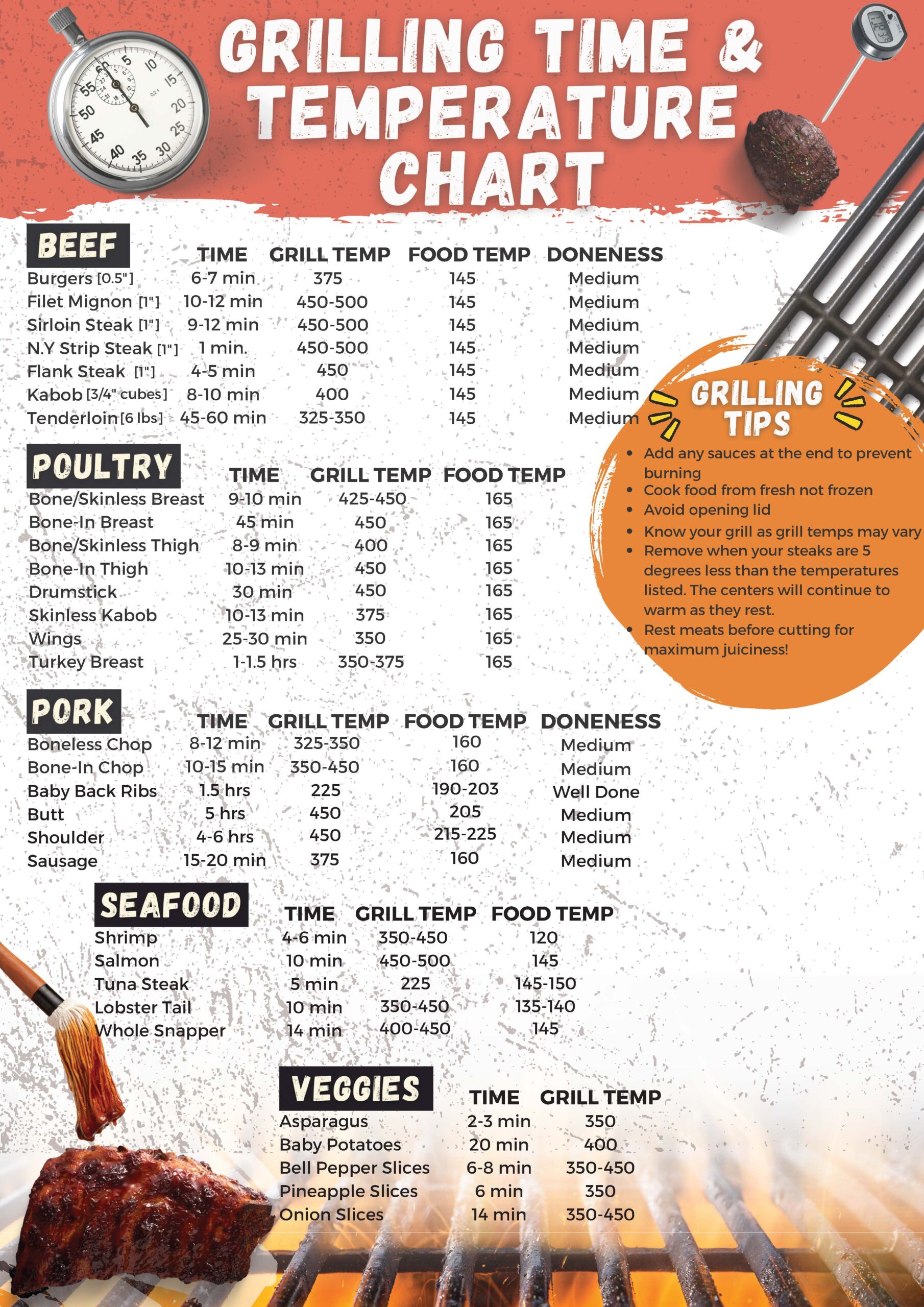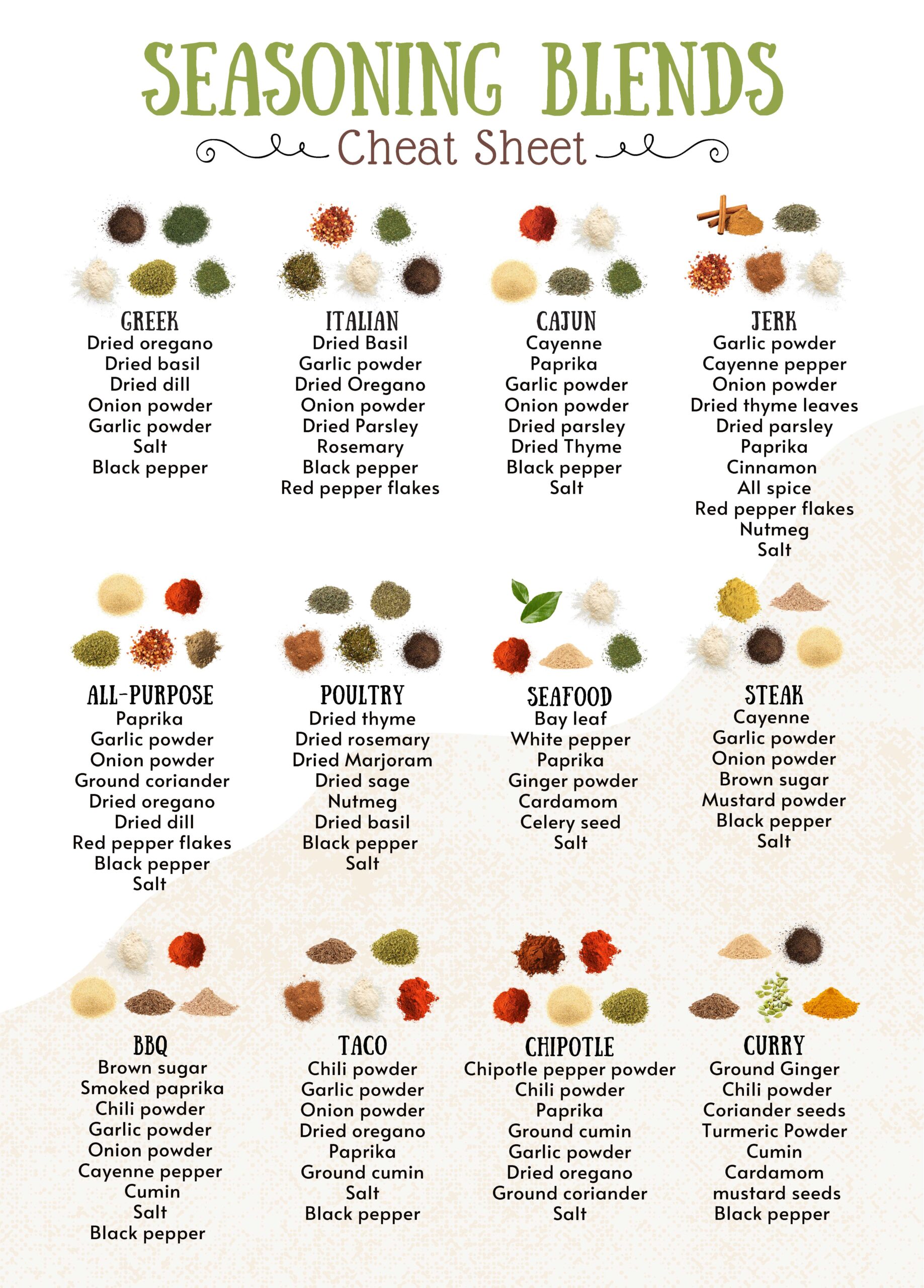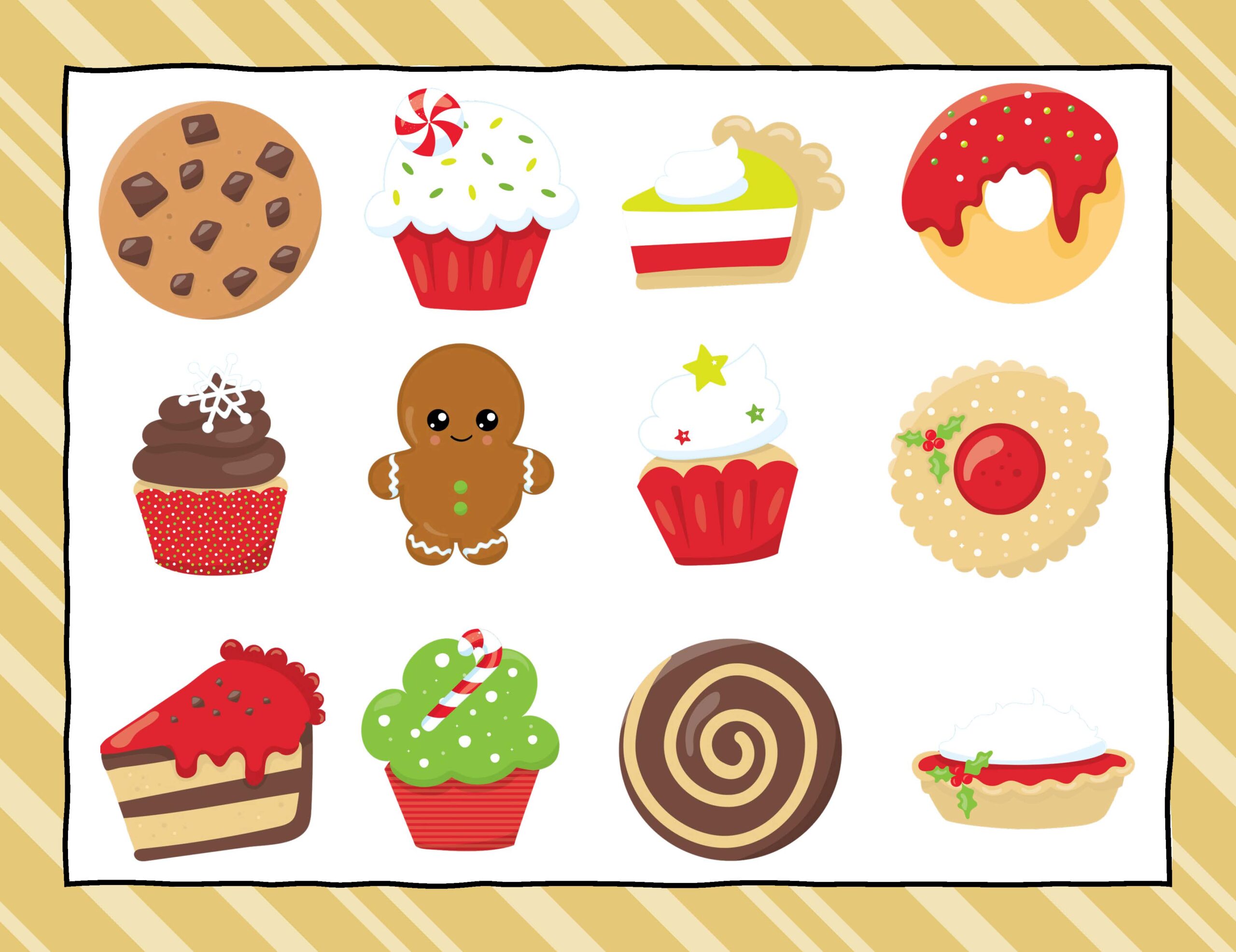Free Printable Grilling Time and Temperature Chart: Your Ultimate Guide to Perfectly Cooked Meat
If you're new to grilling or just looking to improve your grilling skills, you might be wondering how long to grill different types of food and what temperature to cook them at. Fortunately, our free printable grilling time and temperature chart can help take the guesswork out of grilling. Our chart provides recommended grill times and temperatures for a variety of meats, vegetables, and other foods, so you can cook them to perfection every time.

Using a grilling time and temperature chart can be especially helpful if you're cooking for a large group or trying to time multiple dishes on the grill. By following the recommended cook times and temperatures, you'll be able to serve up delicious, perfectly cooked food every time. Plus, having a chart on hand can help you avoid overcooking or undercooking your food, which can be a common problem for novice grillers.
Whether you prefer to grill steak, chicken, fish, vegetables, or burgers, there's a grilling time and temperature chart available that can help you achieve the perfect level of doneness. Simply print out the chart and keep it handy the next time you fire up the grill. With a little practice and the help of a grilling chart, you'll be able to impress your family and friends with your grilling skills in no time!
Free Printable Grilling Time and Temperature Chart: Your Ultimate Guide to Perfectly Cooked Meat
Understanding Grilling Basics
Grilling is a fun and delicious way to cook food, but it can also be intimidating if you're new to it. In this section, we'll cover some basic grilling techniques, how to choose the right cut of meat, and the importance of meat temperature.
Grilling Techniques
There are two main grilling techniques: direct heat and indirect heat. Direct heat is when you place the food directly over the heat source, while indirect heat is when the heat source is off to the side and the food is cooked indirectly. Direct heat is best for cooking small, thin cuts of meat and vegetables, while indirect heat is best for larger cuts of meat and foods that need to cook for a longer period of time.
Choosing the Right Cut of Meat
Choosing the right cut of meat is important for grilling. Different cuts of meat have different textures, flavors, and cooking times. For example, a tenderloin is a lean cut of meat that cooks quickly, while a brisket is a tougher cut of meat that needs to cook for a longer period of time. It's important to choose a cut of meat that is appropriate for the cooking method and the amount of time you have available.
The Importance of Meat Temperature
Meat temperature is an important factor in grilling. It's important to use a meat thermometer to ensure that the meat is cooked to the appropriate internal temperature. For example, chicken should be cooked to an internal temperature of 165°F, while beef should be cooked to an internal temperature of 145°F for medium-rare. It's also important to let the meat rest for a few minutes after it's been cooked to allow the juices to redistribute.
Grilling Time and Temperature Chart
As grilling enthusiasts, we understand the importance of getting the perfect temperature and cooking time for different types of food. That's why having a grilling time and temperature chart is essential for achieving the best results. Here, we will discuss the different grilling times and temperatures for various food types.
Beef and Steaks
When grilling beef and steaks, the temperature is crucial. For rare beef, the internal temperature should be around 125°F, while medium-rare should be around 135°F. Medium beef should be cooked to an internal temperature of 145°F, and well-done beef should be cooked to 160°F. The grilling time for beef and steaks depends on the thickness of the cut and the desired doneness.
Poultry and Chicken
Poultry and chicken should be cooked to an internal temperature of 165°F to ensure that it's safe to eat. The grilling time for chicken varies depending on the cut and size. Boneless chicken breasts take around 6-8 minutes per side, while bone-in chicken takes around 30-40 minutes to cook.
Pork and Ribs
Pork and ribs should be cooked to an internal temperature of 145°F. The grilling time for pork and ribs depends on the cut and thickness. Pork chops take around 6-8 minutes per side, while pork tenderloin takes around 20-25 minutes to cook. Pork ribs should be cooked for around 3-4 hours at a temperature of 225°F.
Seafood and Fish
When grilling seafood and fish, the temperature should be around 145°F. The grilling time for seafood and fish depends on the thickness of the cut. Shrimp takes around 2-3 minutes per side, while salmon takes around 4-6 minutes per side. Lobster tail should be cooked for around 8-10 minutes.
Vegetables and Fruits
Grilling vegetables and fruits can add a smoky flavor to your dish. The grilling time for vegetables and fruits depends on the type and size of the cut. Asparagus takes around 5-7 minutes per side, while kabobs take around 10-15 minutes. It's essential to keep an eye on the food temperature to prevent overcooking.
Perfecting Doneness
When it comes to grilling meat, getting the perfect doneness is key to a delicious meal. It can be tricky to determine when your steak or burger is cooked to perfection, but with our Free Printable Grilling Time and Temperature Chart, we've got you covered. Here are some tips to help you perfect your doneness every time.
Rare to Well Done
The first step to getting the perfect doneness is knowing what you're aiming for. Our grilling chart provides cooking times and temperatures for everything from rare to well done. For example, a rare steak should be cooked to an internal temperature of 125°F, while a well-done steak should be cooked to an internal temperature of 160°F.
Using a Meat Thermometer
One of the best ways to ensure that your meat is cooked to the correct temperature is by using a digital meat thermometer. This handy tool allows you to check the internal temperature of your meat, so you can be sure that it's safe to eat. Simply insert the thermometer into the thickest part of the meat, avoiding any bones, and wait for the reading.
Remember that the internal temperature of the meat will continue to rise even after it's been removed from the grill, so it's important to take it off a few degrees before it reaches your desired doneness. Let it rest for a few minutes before serving, to allow the juices to redistribute throughout the meat.
With our Free Printable Grilling Time and Temperature Chart, you can be confident that your meat will be cooked to perfection every time. Whether you prefer your steak rare, medium rare, medium, or well done, our chart provides the cooking times and temperatures you need to get it just right. So fire up the grill, grab your meat thermometer, and get ready to impress your friends and family with your grilling skills!
Grill Preparation and Safety
Grilling is a fun and delicious way to cook food, but it's important to prioritize safety when preparing your grill. We've put together some tips to help you get started.
Preheating and Cleaning
Before cooking, it's essential to preheat your grill properly. Preheating your grill helps to kill any bacteria on the cooking surface and ensures that your food cooks evenly. We recommend preheating your grill for at least 10-15 minutes before cooking.
It's also essential to clean your grill regularly to prevent the buildup of harmful bacteria. We recommend cleaning your grill after each use to keep it in top condition. You can use a grill brush or scraper to remove any food debris or grease from the grates. For a deeper clean, you can also use soapy water and a sponge to scrub the grates.
Food Safety Considerations
When it comes to grilling, food safety is crucial. We recommend following the USDA's guidelines for safe food handling and cooking temperatures. Always use a meat thermometer to ensure that your food is cooked to the appropriate temperature.
It's also important to consider the safety of reheated food. When reheating leftovers, make sure to heat them to an internal temperature of 165°F to kill any harmful bacteria.
By following these simple tips, you can ensure that your grilling experience is safe and enjoyable for everyone involved.
Enhancing Flavor
Grilling is not just about cooking the food, but also about adding flavor to it. Here are some tips to enhance the taste of your grilled dishes:
Marinades and Sauces
Marinades and sauces can add a lot of flavor to your grilled dishes. Marinades are usually made with oil, vinegar, and spices, and are used to tenderize the meat and add flavor. Sauces, on the other hand, are thicker and can be used to add flavor to the meat or as a dipping sauce.
Some of our favorite marinades include a classic Italian dressing or a mix of soy sauce, honey, and garlic. For sauces, we love a tangy BBQ sauce or a creamy garlic aioli.
Grilling Veggies and Sides
Grilling veggies and sides can also add a lot of flavor to your meal. Tomatoes, pineapple slices, onion slices, bell pepper slices, and portobello mushrooms are all great options for grilling. The heat of the grill caramelizes the natural sugars in the veggies, bringing out their sweetness.
Corn on the cob is another classic side dish that can be grilled to perfection. We like to brush it with butter and sprinkle it with salt and pepper before grilling.
Advanced Grilling Techniques
Smoking and Slow Cooking
When it comes to grilling, smoking and slow cooking are advanced techniques that can take your dishes to the next level. Smoking involves cooking food low and slow over indirect heat, using wood chips or chunks to add flavor. This technique works best with tougher cuts of meat, such as brisket or pork shoulder, which benefit from the long cooking time and smoky flavor.
To smoke your food, set up your grill for indirect cooking and add your wood chips or chunks to the coals. Place your meat on the opposite side of the grill from the heat source and close the lid. Monitor the temperature and adjust the vents as needed to maintain a consistent temperature. Depending on the cut of meat, smoking can take several hours or even overnight.
Slow cooking, on the other hand, involves cooking food over low heat for an extended period of time, typically in a covered grill or smoker. This technique is great for tenderizing tougher cuts of meat and infusing them with flavor. To slow cook your food, set up your grill for indirect cooking and place your meat in a roasting pan or Dutch oven. Cover the pan and cook over low heat for several hours, until the meat is tender and fully cooked.
Expert Tips from Pitmasters
To take your grilling skills to the next level, we turned to the experts: pitmasters. These barbecue masters have years of experience and know all the tricks of the trade. Here are some of their top tips for advanced grilling:
- Use a meat thermometer to ensure your food is cooked to the proper temperature.
- Let your meat rest for a few minutes before slicing to allow the juices to redistribute.
- Experiment with different wood chips and rubs to find your favorite flavor combinations.
- Don't be afraid to try new cuts of meat and cooking techniques.
- Keep a spray bottle of water handy to control flare-ups.
By incorporating smoking and slow cooking techniques, and following the expert tips from pitmasters, you can take your grilling skills to the next level and impress your friends and family with delicious, flavorful dishes.
Related Post:
Grilling Accessories
When it comes to grilling, having the right accessories can make all the difference. Not only can they make the grilling process easier, but they can also help ensure that your food is cooked to perfection. In this section, we will discuss some of the most important grilling accessories, including how to choose the right tools and the differences between instant-read and leave-in thermometers.
Choosing the Right Tools
There are a variety of grilling tools available, from spatulas and tongs to brushes and skewers. When choosing the right tools for your grilling needs, it's important to consider the type of food you will be cooking and the size of your grill. For example, if you plan on grilling large cuts of meat, you may want to invest in a pair of long-handled tongs or a sturdy spatula to help you flip the meat without burning your hands.
Another important consideration when choosing grilling tools is the material they are made from. Stainless steel is a popular choice for grilling tools because it is durable and easy to clean. However, some people prefer tools made from wood or silicone because they are less likely to scratch the surface of their grill.
Instant Read vs. Leave-In Thermometers
One of the most important accessories for grilling is a meat thermometer. A meat thermometer can help you ensure that your food is cooked to the proper temperature, which is especially important when it comes to meat. There are two main types of meat thermometers: instant-read and leave-in.
Instant-read thermometers are designed to give you a quick reading of the temperature of your food. They are great for checking the temperature of thin cuts of meat or for checking the temperature of your food as it cooks. Leave-in thermometers, on the other hand, are designed to be left in your food while it cooks. They are great for monitoring the temperature of larger cuts of meat or for cooking food in the oven.
No matter what type of thermometer you choose, it's important to make sure that it is accurate and easy to read. A good meat thermometer should be able to give you a reading within a few seconds and should be easy to read, even in low light conditions.
-> Download and print our Free Printable Grilling Time and Temperature Chart here! <-

Frequently Asked Questions
How can I determine the correct grilling times and temperatures for various foods?
Determining the correct grilling times and temperatures for various foods can be a bit tricky, but it's an important step to ensure your food is cooked to perfection. The best way to determine the correct grilling times and temperatures is to use a reliable grilling time and temperature chart. These charts will provide you with the recommended grilling time and temperature for a variety of foods, including meats, vegetables, and seafood.
What's the best way to measure the temperature of my grill?
The best way to measure the temperature of your grill is to use a thermometer. There are several types of thermometers available, including digital, instant-read, and probe thermometers. Digital thermometers are the most accurate and easy to read, while instant-read thermometers are ideal for quick temperature checks. Probe thermometers are designed to be left in the meat while it cooks, allowing you to monitor the internal temperature without opening the grill.
Can you provide a simple chart for meat cooking temperatures?
Yes, we can! Here's a simple chart for meat cooking temperatures:
| Meat | Temperature (F) |
|---|---|
| Beef (rare) | 125-130 |
| Beef (medium-rare) | 130-135 |
| Beef (medium) | 135-145 |
| Beef (medium-well) | 145-155 |
| Beef (well-done) | 155-165 |
| Pork | 145 |
| Chicken | 165 |
| Fish | 145 |
How do I convert grilling temperatures to Celsius?
To convert grilling temperatures from Fahrenheit to Celsius, subtract 32 from the Fahrenheit temperature and then multiply by 5/9. For example, if the grilling temperature is 350 degrees Fahrenheit, the Celsius temperature would be (350-32) x 5/9 = 176.67 degrees Celsius.
At what temperature should I grill to achieve a medium-rare or well-done steak?
To achieve a medium-rare steak, grill the steak to an internal temperature of 130-135 degrees Fahrenheit. For a well-done steak, grill the steak to an internal temperature of 155-165 degrees Fahrenheit.
What grill setting corresponds to 350 degrees Fahrenheit?
The grill setting that corresponds to 350 degrees Fahrenheit will depend on your specific grill. However, as a general rule, a medium heat setting on most gas grills will be around 350 degrees Fahrenheit. If you're using a charcoal grill, you can achieve a temperature of 350 degrees Fahrenheit by using about 25-30 briquettes.







